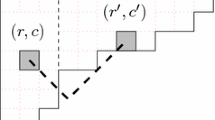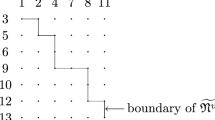Abstract
We consider the Grothendieck polynomials appearing in the K-theory of Grassmannians, which are analogs of Schur polynomials. This paper aims to establish a version of the Murnaghan–Nakayama rule for Grothendieck polynomials of the Grassmannian type. This rule allows us to express the product of a Grothendieck polynomial with a power-sum symmetric polynomial into a linear combination of other Grothendieck polynomials.
Similar content being viewed by others
Availability of Data and Material
The manuscript has no external data. Everything can be found in my manuscript.
References
Sami H. Assaf and Peter R. W. McNamara. A Pieri rule for skew shapes. Journal of Combinatorial Theory - Series A, 118(1), 2011.
Jason Bandlow, Anne Schilling, and Mike Zabrocki. The Murnaghan-Nakayama rule for \(k\)-Schur functions. Journal of Combinatorial Theory, Series A, 118(5):1588–1607, 2011.
Anders S. Buch. A Littlewood-Richardson rule for the \(K\)-theory of Grassmannians. Acta Mathematica, 189(1):37–78, 2002.
Michel Demazure. Désingularisation des variétés de Schubert généralisées. In Annales scientifiques de l’École normale supérieure, volume 7, pages 53–88, 1974.
Sergey Fomin and Curtis Green. Noncommutative Schur functions and their applications. Discrete Mathematics, 193(1-3):179–200, 1998.
Sergey Fomin and Anatol N Kirillov. Grothendieck polynomials and the Yang-Baxter equation. In Proc. Formal Power Series and Alg. Comb, pages 183–190, 1994.
Sergey Fomin and Anatol N Kirillov. The Yang-Baxter equation, symmetric functions, and Schubert polynomials. Discrete Mathematics, 153(1-3):123–143, 1996.
Francesco Gherardelli. Invariant theory: proceedings of the 1st 1982 Session of the Centro Internazionale Matematico Estivo (CIME) held at Montecatini, Italy, June 10-18, 1982, volume 996. Springer, 2006.
Takeshi Ikeda and Hiroshi Naruse. K-theoretic analogues of factorial Schur P- and Q-functions. Advances in Mathematics, 243:22–66, 2013.
Takeshi Ikeda and Tatsushi Shimazaki. A proof of K-theoretic Littlewood-Richardson rules by Bender-Knuth-type involutions. Mathematical Research Letters, 21(2):333–339, 2014.
Anatol N. Kirillov. On some quadratic algebras I 1/2: Combinatorics of Dunkl and Gaudin elements, Schubert, Grothendieck, Fuss-Catalan, universal Tutte and reduced polynomials. SIGMA Symmetry, Integrability and Geometry: Methods and Applications 12:002, 2016.
Bertram Kostant and Shrawan Kumar. \(T\)-equivariant \(K\)-theory of generalized flag varieties. Proceedings of the National Academy of Sciences, 84(13):4351–4354, 1987.
Matjaž Konvalinka. Skew quantum Murnaghan-Nakayama rule. Journal of Algebraic Combinatorics, 35(4):519–545, 2012.
Alain Lascoux. Anneau de Grothendieck de la variété de drapeaux. In The Grothendieck Festschrift, pages 1–34. Springer, 2007.
Cristian Lenart. Combinatorial aspects of the \(K\)-theory of Grassmannians. Annals of Combinatorics, 4(1):67–82, 2000.
Alain Lascoux and Marcel-Paul Schützenberger. Structure de Hopf de l’anneau de cohomologie et de l’anneau de Grothendieck d’une variété de drapeaux. CR Acad Sci Paris Sér I Math, 295(11):629–633, 1982.
Ian G. Macdonald. Notes on Schubert polynomials, volume 6. Dép. de mathématique et d’informatique, Université du Québec à Montréal, 1991.
Ian G. Macdonald. Symmetric functions and Hall polynomials. Oxford university press, 1998.
Andrew Morrison and Frank Sottile. Two Murnaghan-Nakayama rules in Schubert calculus. Annals of Combinatorics, 22(2):363–375, 2018.
Francis D Murnaghan. The characters of the symmetric group. American Journal of Mathematics, 59(4):739–753, 1937.
Tadasi Nakayama. On some modular properties of irreducible representations of a symmetric group, I. In Japanese journal of mathematics: transactions and abstracts, volume 17, pages 165–184. The Mathematical Society of Japan, 1940.
Tadasi Nakayama. On some modular properties of irreducible representations of symmetric groups, II. In Japanese journal of mathematics: transactions and abstracts, volume 17, pages 411–423. The Mathematical Society of Japan, 1940.
Dustin Ross. The loop Murnaghan-Nakayama rule. Journal of Algebraic Combinatorics, 39(1):3–15, 2014.
Dustin Ross and Zhengyu Zong. The gerby Gopakumar-Mariño-Vafa formula. Geometry & Topology, 17(5):2935–2976, 2013.
Vasu Tewari. A Murnaghan-Nakayama rule for noncommutative Schur functions. European Journal of Combinatorics, 58:118–143, 2016.
Mark Wildon. A combinatorial proof of a plethystic Murnaghan-Nakayama rule. SIAM Journal on Discrete Mathematics, 30(3):1526–1533, 2016.
Acknowledgements
This work is supported by the Ministry of Education and Training, Vietnam, under project code B2022-CTT-02: “Study some combinatorial models in Representation Theory”, 2022-2023 (Decision No.1323/QD-BGDDT, May 19, 2022). Khanh would like to express his sincere gratitude for the Visiting Fellowship supported by MathCoRe and Prof. Petra Schwer at Otto-von-Guericke-Universität Magdeburg. He would also like to thank Prof. Cristian Lenart for his strong encouragement and for taking his time to read the manuscript and give valuable comments. Hiep would like to thank Prof. Takeshi Ikeda for introducing Grothendieck polynomials and explaining their importance in the study of K-theory of Grassmannians. Thuy was partially supported by the Vietnam Academy of Science and Technology under grant number DLTE00.04/23-24.
Author information
Authors and Affiliations
Corresponding author
Ethics declarations
Conflict of Interest
On behalf of all the authors, the corresponding author states that there is no conflict of interest.
Additional information
Communicated by Matjaž Konvalinka.
Publisher's Note
Springer Nature remains neutral with regard to jurisdictional claims in published maps and institutional affiliations.
Rights and permissions
Springer Nature or its licensor (e.g. a society or other partner) holds exclusive rights to this article under a publishing agreement with the author(s) or other rightsholder(s); author self-archiving of the accepted manuscript version of this article is solely governed by the terms of such publishing agreement and applicable law.
About this article
Cite this article
Nguyen, DK., Hiep, D.T., Son, T.H. et al. A Murnaghan–Nakayama Rule for Grothendieck Polynomials of Grassmannian Type. Ann. Comb. 28, 155–168 (2024). https://doi.org/10.1007/s00026-023-00659-x
Received:
Accepted:
Published:
Issue Date:
DOI: https://doi.org/10.1007/s00026-023-00659-x




